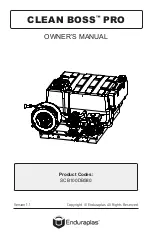
2
※
IMPORTANT SAFETY INSTRUCTIONS
INSTRUCTIONS PERTAINING TO A RISK OF FIRE, ELECTRIC SHOCK, OR INJURY TO PERSONS
WARNING
– When using tools, basic precautions should always be followed, including the following:
a) SAVE THESE INSTRUCTIONS-To reduce the risks of fire or explosion, electrical shock and injury to persons, read and
understand all instructions included in this manual. Be familiar with the controls and the proper usage of the equipment.
b) WARNING-To reduce the risk of fire of explosion:
1) Do not spray flammable or combustible materials near an open flame or sources of ignition such as cigarettes, motors,
and electrical equipment.
2) For units intended for use with only water-based materials-Do not spray or clean with flammable liquids. For use with
water-based liquids only.
3) For units intended for use with only water-based or mineral spirit-type materials with a minimum flash point of 21C°(69.8
F°) Do not spray on clean with liquids having a flash point less than 21C°(69.8 F°)
4) Paint or solvent flowing through the equipment is able to result in static electricity. Static electricity creates a risk of fire or
explosion in the presence of paint or solvent fumes. All parts of the spray system, including the pump, hose assemble,
spray gun, and objects in and around the spray area shall be properly grounded to protect against static discharge and
sparks. Use only conductive or grounded high-pressure airless paint sprayer hoses specified by the manufacturer.
5) Verify that all containers and collection systems are grounded to prevent static discharge.
6) Connect to a grounded outlet and use grounded extension cords. Do not use a 3 to 2 adapter.
7) Do not use a paint or a solvent containing halogenated hydrocarbons. See operating instructions for examples of these
types of materials.
8) Keep spray area well ventilated. Keep a good supply of fresh air moving through the area. Keep pump assembly in a well
ventilated area. Do not spray pump assembly.
9) Do not smoke in the spray area.
10) Do not operate light switches, engines, or similar spark producing products in the spray area.
11) Keep area clean and free of paint or solvent containers, rags, and other flammable materials.
12) Know the contents of the paints and solvents being sprayed. Read all Material safety Data Sheets (MSDS) and container
labels provided with the paints and solvents
. Follow the paint and solvent manufacturer’s safety instructions.
13) Fire extinguisher equipment shall be present and working.
c) WARNING-To reduce the risk of skin injection.
1) Do not aim the gun at, or spray any person or animal.
2) Keep hands and other body parts away from the discharge. For example, do not try to stop leaks with any part of the
body.
3) Always use the nozzle tip guard. Do not spray without nozzle tip guard in place.
4) Only use a nozzle tip specified by the manufacturer.
5) Use caution when cleaning and changing nozzle tips. In the case where the nozzle tip clogs while spraying, follow the
manufacturer’s instructions for turning off the unit and relieving the pressure before removing the nozzle tip to clean.
6) Do not leave the unit energized or under pressure while unattended. When the unit is not in use, turn off the unit and
relieve the pressure in accordance with the manufacturer’s instructions.
7) High-pressure spray is able to inject toxins into the body and cause serious bodily injury. In the event that injection occurs,
seek medical attention immediately.
8) Check hose and parts for signs of damage. Replace and damaged hoses of parts.
9) This system is capable or producing 20.7Mpa. Only use replacement parts or accessories that are specified by the
manufacturer and that are rated a minimum of 22.8Mpa.
10) Always engage the trigger lock when not spraying. Verify the trigger lock is functioning properly.
11) Verify that all connections are secure before operating the unit.
12) Know how to stop the unit and bleed pressure quickly. Be thoroughly familiar with the controls.
d) WARNING-To reduce the risk of injury.

































